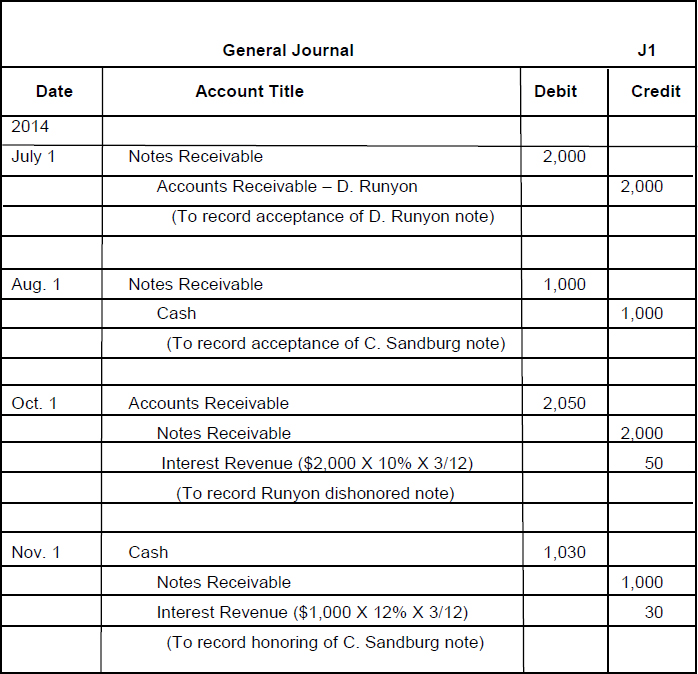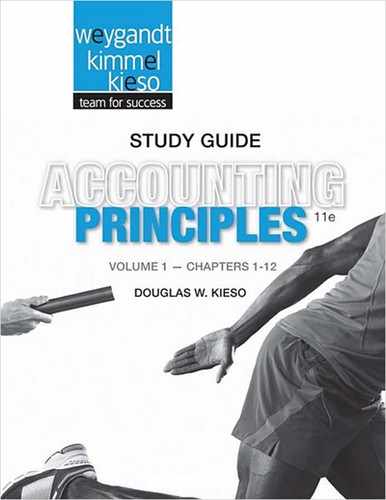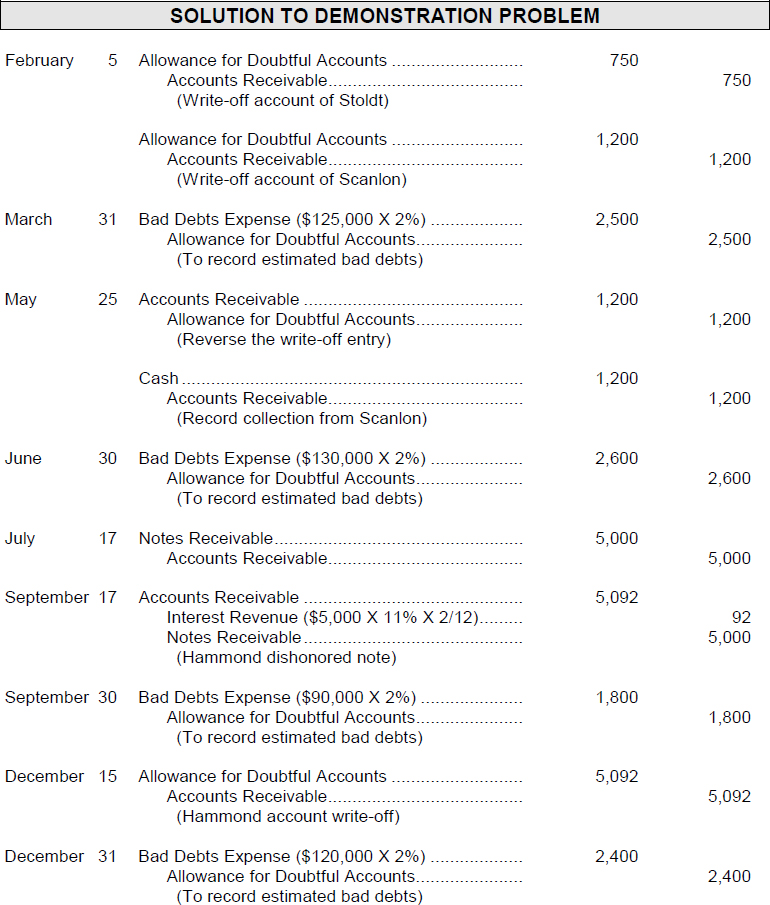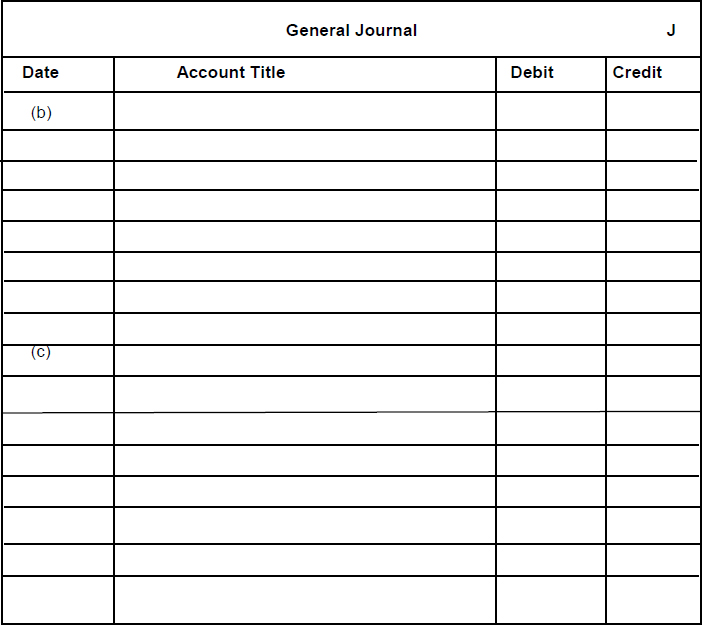Chapter 9
ACCOUNTING FOR RECEIVABLES
| The Navigator | |
CHAPTER LEARNING OBJECTIVES
After studying this chapter, you should be able to:
1. Identify the different types of receivables.
2. Explain how companies recognize accounts receivable in the accounts.
3. Distinguish between the methods and bases companies use to value accounts receivable.
4. Describe the entries to record the disposition of accounts receivable.
5. Compute the maturity date of and interest on notes receivable.
6. Explain how companies recognize notes receivable in the accounts.
7. Describe how companies value notes receivable.
8. Describe the entries to record the disposition of notes receivable.
9. Explain the statement presentation and analysis of receivables.
*10. Compare the accounting procedures for receivables under GAAP and IFRS.
![]()
PREVIEW OF CHAPTER 9
The content and organization of this chapter is as follows:

![]()
CHAPTER REVIEW
- (L.O. 1) Receivables are claims that are expected to be collected in cash. The three major classes of receivables are usually classified as: (a) accounts, (b) notes, and (c) other.
- Accounts receivable are amounts customers owe on account. Notes receivable are a written promise (as evidenced by a formal instrument) for amounts to be received. And other receivables include nontrade receivables such as interest receivable, loans to company officers, advances to employees, and income taxes refundable.
Recognizing Accounts Receivable
3. (L.O. 2) When a business sells merchandise to a customer on credit, Accounts Receivable is debited and Sales Revenue is credited.
4. If a payment is received by a customer within the discount period, the following entry is made:

Valuing Accounts Receivable
5. (L.O. 3) In accounting, credit losses are debited to Bad Debts Expense or Uncollectible Accounts Expense. Such losses are considered to be a normal and necessary risk of doing business. Two methods are used in accounting for uncollectible accounts: (a) the direct write-off method and (b) the allowance method.
Direct Write-off Method
6. Under the direct write-off method, bad debt losses are not anticipated and no allowance account is used.
a. No entries are made for bad debts until an account is determined to be uncollectible at which time the loss is charged to Bad Debts Expense.
b. This method makes no attempt to match bad debts expense to sales revenue in the income statement or to show the cash realizable value of the accounts receivable in the balance sheet.
c. This method is not acceptable for financial reporting purposes, unless bad debt losses are insignificant.
7. The allowance method is required when bad debts are material in amount. Its essential features are:
a. Uncollectible accounts are estimated and the expense for the uncollectible accounts is matched against sales in the same accounting period in which the sales occurred.
b. Estimated uncollectibles are debited to Bad Debts Expense and credited to Allowance for Doubtful Accounts through an adjusting entry at the end of each period.
c. Actual uncollectibles are debited to Allowance for Doubtful Accounts and credited to Accounts Receivable at the time a specific account is written off.
8. When there is a recovery of an account that has been written off as uncollectible, it is necessary to:
a. reverse the entry made when the account was written off, and
b. record the collection in the usual manner.
9. There are two bases that are used to determine the amount of expected uncollectibles. One is the percentage of sales basis, and the other is the percentage of receivables basis.
Percentage of Sales Basis
10. Under the percentage of sales basis,
a. Management establishes a percentage relationship between the amount of credit sales and expected losses from uncollectible accounts.
b. The expected bad debt losses are determined by applying the percentage to the sales base of the current period.
c. This basis better matches expenses with revenues.
Percentage of Receivables Basis
11. Under the percentage of receivables basis,
a. The balance in the allowance account is derived from an analysis of individual customer accounts. The analysis is often called aging the accounts receivable.
b. The amount of the adjusting entry is the difference between the required balance and the existing balance in the allowance account.
c. This basis produces the better estimate of cash realizable value of the accounts receivable.
Disposing of Accounts Receivable
12. (L.O. 4) In order to accelerate the receipt of cash from receivables, businesses frequently (1) sell to a factor such as a finance company or bank, or (2) make credit card sales.
13. A factor buys receivables from businesses for a fee and then collects the payments directly from the customers. The entry for a sale to a factor is:

14. Credit cards are frequently used by retailers because the retailer does not have to be concerned with the customer's credit history and the retailer can receive cash more quickly from the credit card issuer. However, the credit card issuer usually receives a fee of from 2-6% of the invoice price from the retailer.
15. (L.O. 5) A promissory note is a written promise to pay a specified amount of money on demand or at a definite time. The party making the promise is called the maker; the party to whom payment is made is called the payee.
16. When the life of a note is expressed in terms of months, the due date is found by counting the months from the date of issue. When the due date is stated in terms of days, it is necessary to count the days. In counting days, the date of issue is omitted but the due date is included.
17. The basic formula for computing interest on an interest bearing note is:

Recognizing Notes Receivable
18. (L.O. 6) Entries for notes receivable are required when the note is received and at maturity. To illustrate, assume that on June 1, 2014, Raider Company receives a $2,000, 3-month, 12% note receivable from Paul Revere in settlement of an open account. The entry is:
![]()
Valuing Notes Receivable
19. (L.O. 7) Like accounts receivable, short-term notes receivable are reported at their cash (net) realizable value and an Allowance for Doubtful Accounts is used.
Disposing of Notes Receivable
20. (L.O. 8) On September 1, the maturity date, Paul Revere honors the note by paying the face amount, $2,000 plus interest of $60 ($2,000 × 12% × 3/12). Assuming that interest has not been accrued, the entry is:

21. (L.O. 9) In the balance sheet, short-term receivables are reported within the current assets section below short term investments. Both the gross amount of receivables and the allowance for doubtful accounts should be reported. In a multiple-step income statement, Bad Debts Expense and Service Charge Expense are reported as selling expenses in the operating expenses section.
*22. (L.O. 10) The basic accounting and reporting issues related to recognition and measurement of receivables, such as allowance accounts, how to record discounts, use of the allowance method to account for bad to debts, and factoring are essentially the same between IFRS and GAAP.
*23. IFRS requires that loans and receivables be accounted for at amortized cost, adjusted for allowances for doubtful accounts.
*24. IFRS requires a two-tiered approach to test whether the value of loans and receivables are impaired. First, a company should look at specific loans and receivables and determine whether they are impaired. Then, the loans and receivables as a group should be evaluated for impairment. GAAP does not prescribe a similar two-tiered approach.
*25. IFRS and GAAP differ in the criteria used to determine how to record a factoring transaction. IFRS is a combination of an approach focused on risks and rewards and loss of control. GAAP uses loss of control as the primary criterion. In addition, IFRS permits partial derecognition of receivables; GAAP does not.
![]()
![]()
REVIEW QUESTIONS AND EXERCISES
TRUE—FALSE
Indicate whether each of the following is true (T) or false (F) in the space provided.
![]()
MULTIPLE CHOICE
Circle the letter that best answers each of the following statements.
- (L.O. 1) Which of the following are also called trade receivables?
- Accounts receivable.
- Other receivables.
- Advances to employees.
- Income taxes refundable.
- (L.O. 2) On February 1, 2014, Chudzick Company sells merchandise on account to Livingston Company for $5,000. The entry to record this transaction by Chudzick Company is:

Questions 3 and 4 are based on the following information: On March 1, 2014, Etheredge, Inc. sells merchandise on account to Brooks Company for $7,000 terms 2/10, n/30. On March 3, Brooks returns $500 of the merchandise to Etheredge. On March 9, payment is received from Brooks for the balance due.
3. (L.O. 2) The entry on March 3 by Etheredge is:

4. (L.O. 2) The entry on March 9 by Etheredge is:

5. (L.O. 3) When the allowance method of recognizing bad debts expense is used, the entry to recognize that expense:
a. increases net income.
b. decreases current assets.
c. has no effect on current assets.
d. has no effect on net income.
6. (L.O. 3) A basis of estimating uncollectible accounts that focuses on the income statement rather than the balance sheet is the:
a. direct write-off of receivables.
b. aging of the accounts receivable.
c. percentage of sales.
d. percentage of receivables.
7. (L.O. 3) White Company provides for bad debts expense at the rate of 2% of credit sales. The following data are available for 2014:

The Allowance for Doubtful Accounts balance at December 31, 2014, should be:
a. $68,000.
b. $60,000.
c. $50,000.
d. $13,000.
8. (L.O. 3) In 2014, the Slowe Company had credit sales of $600,000 and granted sales discounts of $12,000. On January 1, 2014, Allowance for Doubtful Accounts had a credit balance of $15,000. During 2014, $25,000 of uncollectible accounts receivable were written off. Past experience indicates that 3% of net credit sales become uncollectible. What should be the adjusted balance of Allowance for Doubtful Accounts at December 31, 2014?
a. $7,640.
b. $8,000.
c. $17,640.
d. $33,000.
9. (L.O. 3) An analysis and aging of the accounts receivable of Green Company at December 31 revealed the following data:

The cash realizable value of the accounts receivable at December 31, after adjustment, is:
a. $593,000.
b. $525,000.
c. $518,000.
d. $443,000.
10. (L.O. 3) Voight Company's account balances at December 31 for Accounts Receivable and Allowance for Doubtful Accounts were $1,400,000 and $70,000 (Cr.), respectively. An aging of accounts receivable indicated that $108,000 are expected to become uncollectible. The amount of the adjusting entry for bad debts at December 31 is:
a. $108,000.
b. $38,000.
c. $178,000.
d. $70,000.
11. (L.O. 3) Bonnie Company decides that the past-due account of Sheldon Stahl is uncollectible. Under the allowance method, the $865 balance owed by Sheldon Stahl is written off as follows:

12. (L.O. 3) Aurora Company has insignificant bad debt losses and therefore uses the direct write-off method. On October 19, the $300 balance of Mary Vonesh becomes uncollectible. The entry to record the write-off is:

13. On March 1, 2014, Tom Zarle purchased a suit at Madden's Fine Apparel Store. The suit cost $350 and Tom used his Madden credit card. Madden charges 2% per month interest if payment on credit charges is not made within 30 days. On April 30, 2014, Tom had not yet made his payment. What entry should Madden make on April 30th?

14. (L.O. 4) Gudenas Co., makes a credit card sale to a customer for $250. The credit card sale has a grace period of 30 days and then an interest charge of 18% per year or 1.5% per month is added to the balance. If the unpaid balance on the above sale is $150 at the end of the grace period, the interest charge is:
a. $3.75.
b. $3.00.
c. $1.50.
d. $2.25.
15. (L.O. 4) On October 1, 2014, Arteberry Company sells (factors) $300,000 of receivables to Church Factors, Inc. Church assesses a service charge of 3% of the amount of receivables sold. The journal entry to record the sale by Arteberry will include:
a. a debit of $300,000 to Accounts Receivable.
b. a credit of $309,000 to Cash.
c. a debit of $309,000 to Cash.
d. a debit of $9,000 to Service Charge Expense.
16. (L.O. 5) On April 3, 2014, Sublette, Inc. issued a promissory note to Biterman Company that was to mature in 90 days. The maturity date of the 90-day note is:
a. July 1, 2014.
b. July 2, 2014.
c. July 3, 2014.
d. July 4, 2014.
17. (L.O. 5) On February 1, Lowery Company received a $5,000, 10%, four-month note receivable. The cash to be received by Lowery Company when the note becomes due is:
a. $167.
b. $5,000.
c. $5,167.
d. $5,500.
Questions 18 and 19 are based on the following information: On February 15, 2014, Gilbert Company received a two-month, 10%, $2,000 note from Vincent Nathan for the settlement of his open account.
18. (L.O. 6) The entry by Gilbert Company on February 15, 2014 is:

19. (L.O. 8) The entry by Gilbert Company on April 15, 2014 if Nathan dishonors the note and collection is expected is:

20. (L.O. 9) Which of the following statements concerning receivables is incorrect?
a. Notes receivable are often listed last under receivables.
b. The contingent liability from selling notes receivable should be disclosed.
c. Both the gross amount of receivables and the allowance for doubtful accounts should be reported.
d. Interest revenue and gain on sale of notes receivable are shown under other revenues and gains.
![]()
MATCHING
Match each term with its definition by writing the appropriate letter in the space provided.
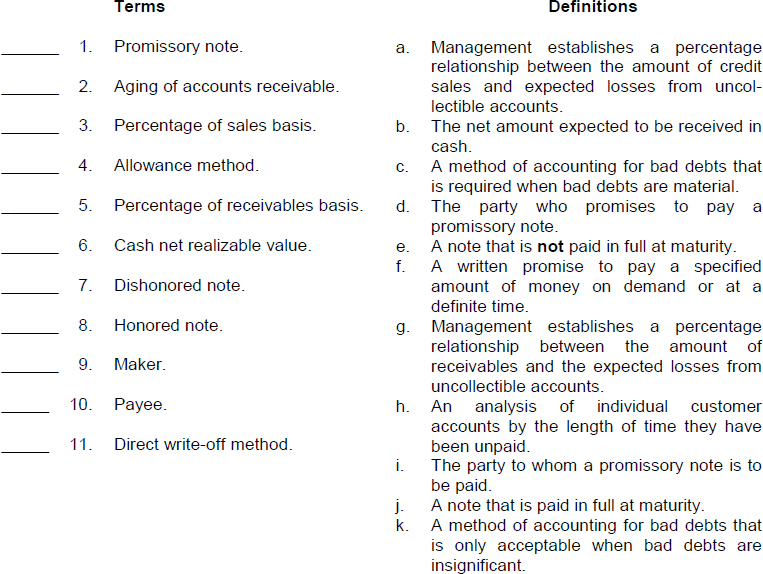
![]()
EX. 9-1 (L.O. 3) The N. Hawthorne Co. had a credit balance in Allowance for Doubtful Accounts of $10,000 at January 1, 2014. During 2014 credit sales totaled $300,000. A summary of the aging of accounts receivable at December 31, 2014 is as follows:

On April 2, 2014, $750 was received from Hermann Hesse; his account for $750 had been written off as uncollectible in 2013. During 2014, accounts receivable totaling $8,400 were written off as uncollectible.
Instructions
(a) Prepare the journal entries on April 2 for the collection of the account previously written off and a summary entry on December 31 for the accounts written off in 2014.
(b) Assuming N. Hawthorne Co. estimates uncollectibles as 2% of credit sales, prepare the adjusting entry at December 31, 2014.
(c) Assuming the N. Hawthorne Co. estimates uncollectibles by using the percentage of accounts receivables, prepare the adjusting entry at December 31, 2014 (use an aging schedule).

EX. 9-2 (L.O. 5, 6, 7, and 8) Hemingway Company had the following transactions for the year ended December 31, 2014.
| July 1 | Received a $2,000, three-month 10% promissory note from Damon Runyon in settlement of an open account. |
| Aug. 1 | Received a $1,000, three-month 12% note receivable from Carl Sandburg for cash borrowed by Sandburg. |
| Oct. 1 | Received notice that the Damon Runyon note had been dishonored. It is expected that Runyon will eventually pay the amount owed. |
| Nov. 1 | Sandburg honored the note receivable in full. (Assume that interest has not been accrued.) |
Prepare the entries for the transactions above.
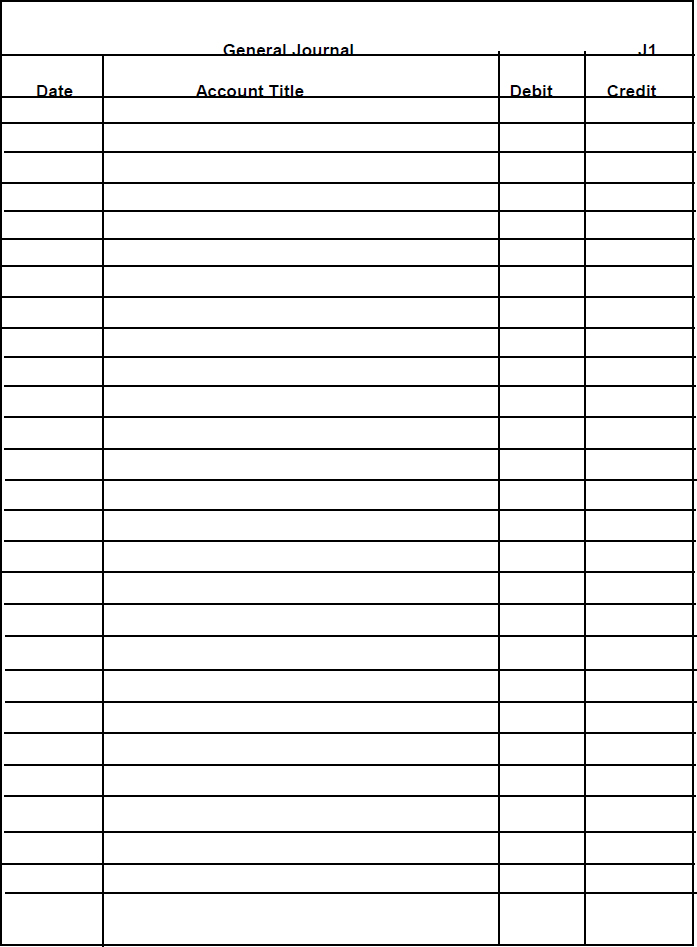
![]()
SOLUTIONS TO REVIEW QUESTIONS AND EXERCISES
TRUE-FALSE
| 1. (F) | Accounts receivable generally are expected to be collected within 30 to 60 days. |
| 2. (T) | |
| 3. (F) | The two methods are (a) the allowance method and (b) the direct write-off method. |
| 4. (T) | |
| 5. (F) | Actual uncollectibles are debited to Allowance for Doubtful Accounts and credited to Accounts Receivable at the time the specific account is written off. |
| 6. (T) | |
| 7. (F) | The account Allowance for Doubtful Accounts is a contra asset account on the balance sheet and is therefore a permanent account that is not closed out. |
| 8. (F) | Two entries are required to record the recovery of a bad debt: (1) the entry made in writing off the account is reversed to reinstate the customer's account, and (2) the collection is journalized in the usual manner. |
| 9. (T) | |
| 10. (T) | |
| 11. (T) | |
| 12. (T) | |
| 13. (T) | |
| 14. (T) | |
| 15. (F) | The three parties are (a) the credit card issuer, (b) the retailer, and (c) the customer. |
| 16. (F) | A promissory note is a written promise to pay a specified amount of money on demand or at a definite time. |
| 17. (F) | When counting the exact number of days to determine the maturity date, the date of issue is omitted but the due date is included. |
| 18. (T) | |
| 19. (F) | Short-term receivables are reported in the current asset section immediately after temporary investments. |
| 20. (T) |
MULTIPLE CHOICE
MATCHING
- f
- h
- a
- c
- g
- b
- e
- j
- d
- i
- k
EX. 9-1
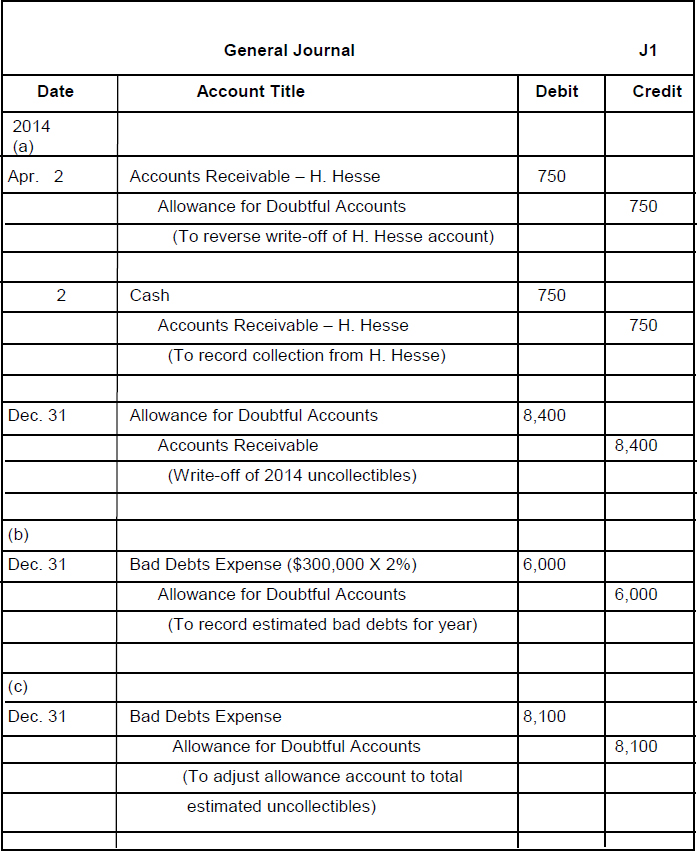
The balance in Allowance for Doubtful Accounts prior to adjustment is $2,350 (Cr.) ($10,000 + $750 - $8,400). Therefore, the adjusting entry is $8,100 ($10,450 - $2,350).
EX. 9-2
